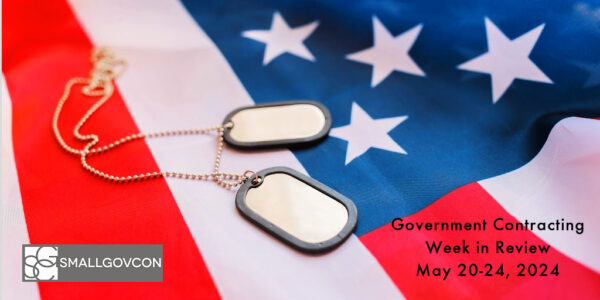We get a lot of questions about federal government contracting as federal government contracting attorneys, which makes sense. One thing we get asked about a lot is the Buy American Act. This is also unsurprising, as the government really did not do the best job in making it clear what this act does. We have talked about the Act before, but now, let’s take a deeper dive into it.
Continue readingCategory Archives: Federal Government Contracting
SmallGovCon Week in Review: June 10-14, 2024

Happy Friday! The weather gave us a taste of summer with a heat index of over 100 degrees here in the Midwest. We are grateful for air conditioning here at SmallGovCon. We hope you have been staying cool and have some fun things planned for the weekend. Enjoy!
This week in federal government contracting news there is buzz about AI procurement, supply chain risks, and timing changes on the 8(a) and WOSBS programs from SBA.
Continue readingSmallGovCon Week in Review: June 3-7, 2024

It’s Friday, which means it’s time for another week in review. We hope you have had a productive week and are ready for a great weekend. This week saw some interesting news including an SBA rule to eliminate self-certification for service-disabled veteran-owned small businesses that are awarded Federal Government contracts or subcontracts. You can read more in the link below and we will be blogging on this new development, as well.
Have a great weekend!
Continue readingEvent! MyGovWatch Live: The B2G Roundtable, June 19, 2024, 12:00pm CDT
If you’re interested in winning more B2G business through the bid process, but you don’t have all the answers, join this LIVE forum and talk about this market with people who have helped hundreds of companies win BILLIONS of dollars in government contracts. This month’s co-hosts are, our very own Koprince McCall Pottroff LLC’s, Nicole Pottroff and Gregory Weber who will be joining, Angela Seymour, a seasoned procurement and GovCon professional with an impressive background in public service spanning nearly two decades.
The event host, Nick Bernardo, President & founder of MyGovWatch.com, has over 20 years of experience helping companies of all sizes figure out how to find, compete for, and actually win government contracts. Sign up now to join this free opportunity to speak with experts, who have actually helped people succeed in GovCon, who can answer ALL your questions. Registration link here.
SmallGovCon Week in Review: May 27-31, 2024

Happy Friday! Can you believe that tomorrow is already June? We are getting some rain here in the Midwest to kick off summer, so I’m sure those lawn mowers will be out in full force this weekend. My tomato plants are growing tall and it won’t be long before we have an abundance of summer produce. We hope you have a wonderful weekend and can get out and enjoy some sunshine.
This week in federal contracting news, there are new contracts coming out in the telecom and IT sectors, and DoD is looking to update how it deals with data management.
Continue readingSmallGovCon Week in Review: May 20-24, 2024

Memorial Day weekend is almost here, which means the unofficial start to summer! Whether you are hitting the road or relaxing at home, I hope you have an enjoyable long weekend while remembering those that have given their lives to protect our country.
Of course, a relaxing weekend isn’t complete without some good reading material, and we’ve got you covered. This week in federal government contracting news….
Continue readingGovology Webinar: June 6, 2024 – Understanding and Complying with the Nonmanufacturer Rule (2024 Update)

The nonmanufacturer rule is one that is commonly misunderstood in the federal government contracting realm. But it is also one we encounter quite often in our role assisting federal contractors. Despite its seemingly straightforward definition, being classified as a “nonmanufacturer” entails more than simply not being the manufacturer.
On June 6, please join my colleagues, Nicole Pottroff & Greg Weber, as they dissect the complexities of this rule and answer your questions. The webinar will be hosted by our friends at Govology, and it is easy to register: just click here.
